Category: NYC History
Seneca Village
On a walking tour organized by the Central Park Conservancy this clear and chilly Sunday afternoon.
Our group of about a dozen met a pair of guides inside the Park at the Mariner’s Gate entrance at 85th Street. From there, we set off to tour the lands that once made up Seneca Village, Manhattan’s first known community of African American property owners. The village, founded in 1825, once occupied the land between what is now the Great Lawn to Central Park West and from 82nd to 89th Streets — an area of about five acres. Within a few years, the community developed into a stable settlement of over 250 working-class residents, with its own churches, school and cemetery. African Americans owned more than half the households in the village — an unusually high percentage of property ownership for any New York community. By the 1840s, Irish and German immigrants, and perhaps Native Americans, owned several land plots as well; in total, during its over three decades in existence, approximately 1,600 people owned property, lived and/or worked in Seneca Village.
Up the trail to Summit Rock — at 141.8 feet, the highest elevation in Central Park (but not the highest point in Manhattan.)
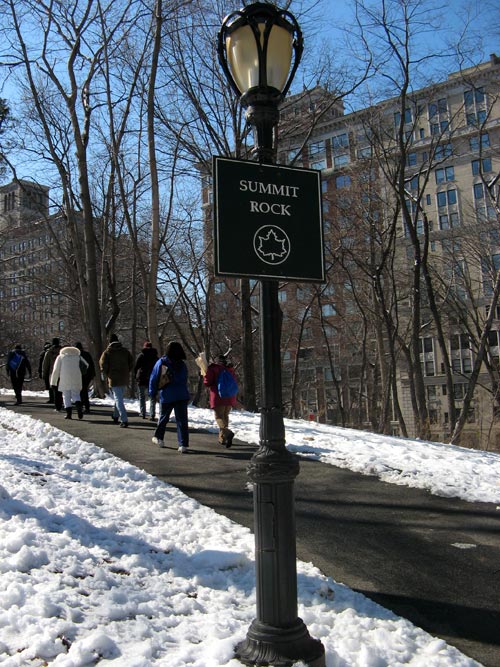
The guides explained the challenges of this particular park tour, as nothing of note remains of the original community, save for the trickling remnants of an abundant natural spring near 82nd Street which would have served as the village’s main source of fresh drinking water. Instead, we were given photocopies of historic maps, and shown artists’ renderings of the structures that would have existed in the mid-19th century. This view overlooks what would have been the heart of Seneca Village.
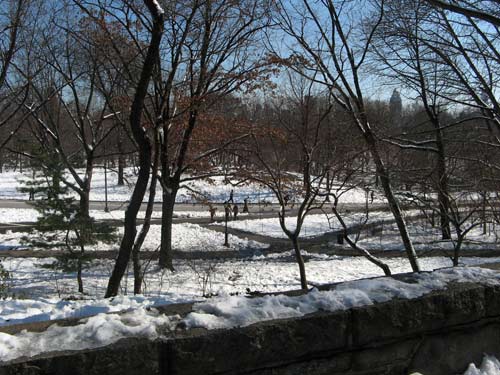
In 1855, the New York State Census reported approximately 264 residents in the semi-rural village, at a time when most of the city’s immigrant population was concentrated in slums below 14th Street. Two years later, after the state legislature authorized the use of eminent domain to publicly acquire private land for the purpose of creating Central Park, the entire village was razed without a trace. Landowners living within the boundaries of the proposed park were compensated financially for their property, though several filed claims in New York State Supreme Court, protesting the city’s valuations of their land. Little is known of the outcome of those lawsuits, or where the hundreds of residents may have relocated. What is known is that once scattered, the community of Seneca Village was not re-established.
This spot of red is a cardinal, hidden among the trees:

Winterdale Arch at 82d Street, a pedestrian underpass and bridle path. The 1994 restoration included the award-winning recreation of the original cast-iron fencing along the top of the arch:
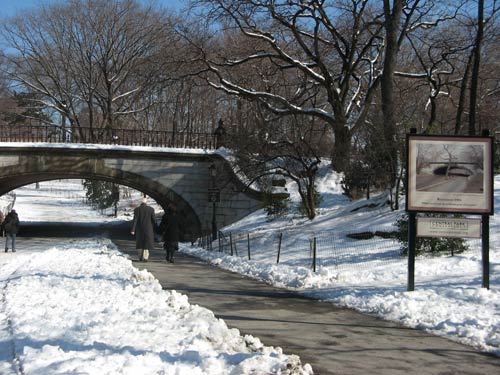
Washington Square Park in progress
After years of protests led by the Open Washington Square Park Coalition, Justice Joan A. Madden of State Supreme Court in Manhattan approved Washington Square Park’s renovation plan in early December.
The work includes moving the park’s fountain, shrinking the central plaza and raising it to street level grade — transforming the park into a garden-style pass-through mall, surrounded by a four-foot fence, which critics claim will make the park less hospitable to spontaneous gatherings.
I remember a time when the “spontaneous gatherings” were mostly drug dealers, pouncing upon and offering their wares to every junior high schooler who happened to cut through the park.
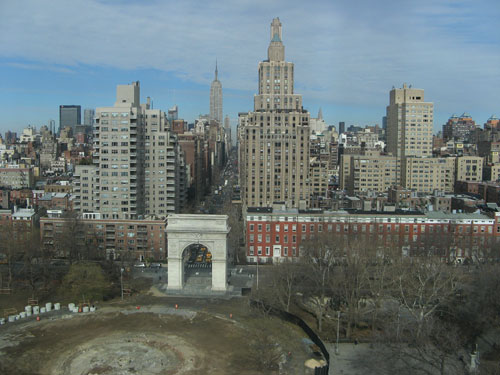
Saturday in Saugerties
The dreaded stomach virus that has been running rampant throughout the city continued to wreak havoc on my social calendar when both gatherings scheduled for this weekend were canceled due to friends’ illnesses. (Get well soon!)
So instead, a one-day getaway to Saugerties, probably best known as the site of the 1994 Woodstock Festival revival. This quaint, historic town is located in Ulster County, in the heart of the Hudson River Valley. We were just 100 miles out of the city, but here, the streets were patched with winter snow. (Remember snow?)
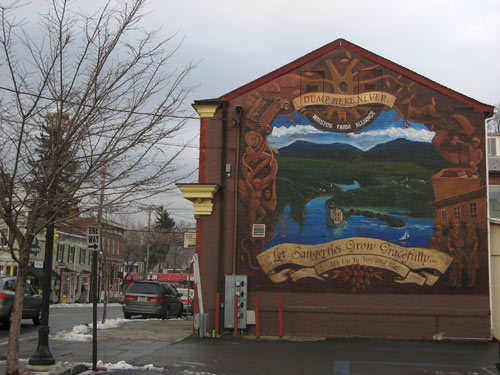
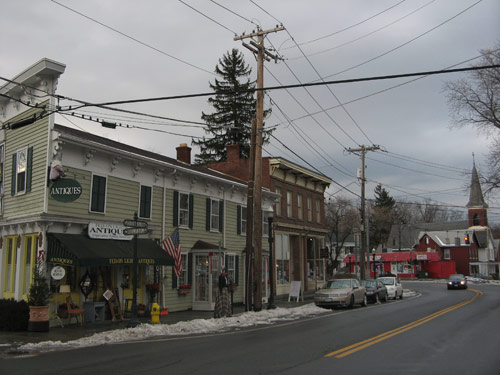
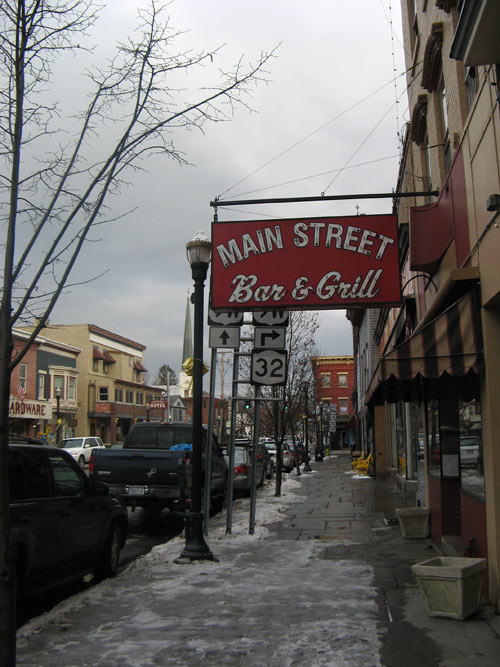
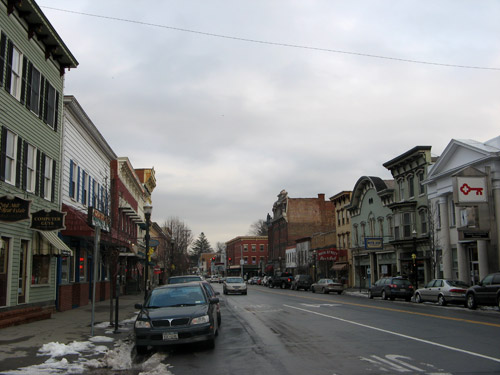
In 1677, New York’s Governor Edmund Andros agreed to purchase the land which now comprises the town from the Esopus Indian tribe for the price of a blanket, a piece of cloth, a shirt, a loaf of bread, and some coarse fiber. The deal recalls a similar transaction half a century earlier, between the Director-General of the Dutch colony of New Netherland, Peter Minuit, and the Lenape tribe, in which the island of Manhattan was exchanged for 60 guilders — those 24 famous dollars — worth of beads and trinkets.
| S | M | T | W | T | F | S |
|---|---|---|---|---|---|---|
| 1 | 2 | 3 | 4 | 5 | 6 | |
| 7 | 8 | 9 | 10 | 11 | 12 | 13 |
| 14 | 15 | 16 | 17 | 18 | 19 | 20 |
| 21 | 22 | 23 | 24 | 25 | 26 | 27 |
| 28 | 29 | 30 | ||||
Search
Popular Tags
Categories
Archive
- July 2010
- July 2009
- January 2009
- November 2008
- September 2008
- August 2008
- July 2008
- June 2008
- May 2008
- April 2008
- March 2008
- February 2008
- January 2008
- December 2007
- November 2007
- October 2007
- September 2007
- August 2007
- July 2007
- June 2007
- May 2007
- April 2007
- March 2007
- February 2007
- January 2007
- December 2006
- November 2006
- October 2006
- September 2006
- August 2006
- July 2006
- June 2006